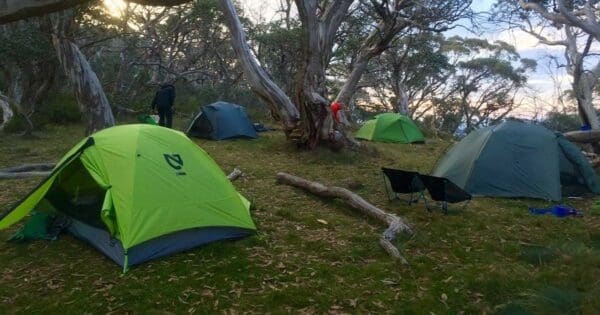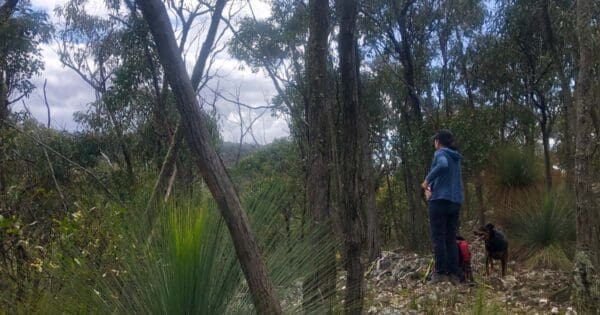Australia’s diverse and wild landscapes are home to some of the most stunning hiking trails in the world — and also to some of the most venomous snakes. From spring through to winter (yes, that’s most of the year!), snakes are active across the country, especially in warmer weather. While the risk of a bite is low if you’re prepared, it’s essential to understand how to minimise encounters and what to do if the unexpected happens.
Whether you’re new to hiking or a seasoned adventurer, staying snake-safe is part of being a responsible trail user. This guide will help you hike with confidence by covering the essentials of snake awareness, prevention, and first aid — including how to apply the Pressure Immobilisation Technique (PIT) in case of a bite.

Here’s a list of tips to help you avoid snakes in Australia
- Stay on designated paths and trails: Stick to well-trodden paths and avoid walking through tall grass, undergrowth, or areas where snakes may be hiding.
- Wear appropriate footwear: Sturdy, closed-toe shoes or boots offer better protection from bites.
- Be cautious in snake habitats: Be especially alert in rocky outcrops, grasslands, forests, and other known snake habitats. Stay on the trail and out of tall grass. If you must enter potential snake territory, wear long pants, ankle-high boots, or snake-proof gaiters.
- Watch where you put your hands and feet: Avoid reaching into places you can’t see, such as under logs or rocks. Kick ahead in grass or leaf litter to give snakes a chance to move away.
- Use a torch at night: Snakes can be more active after dark — always illuminate your path.
- Keep your campsite tidy: Clear away clutter, debris, and long grass where snakes may hide.
- Avoid disturbing snakes: If you spot one, give it space and do not try to touch or provoke it. Most will move away if left alone.
- Stay alert and observe warning signs: Look for local signage indicating snake activity and follow all advice from park authorities.
- Educate yourself about snake identification: Learn about local species, their behaviour, and preferred environments.
- Keep pets under control: Pets can attract or provoke snakes. Keep them leashed and close by.
- Carry a snake bite kit: In remote areas, bring a kit with pressure bandages and know how to use it.
- Take a course in wilderness first aid: Learn how to respond to a snake bite and other emergencies — it could save a life.
- Know what to do in case of a bite: Stay calm and still. Immobilise and wrap the bitten limb. Call 000 immediately. If you’re out of reception, activate your PLB or use a satellite communicator. Do not use ice, tourniquets, or attempt to suck out the venom.
First Aid for Bites and Stings
How to Apply the Pressure Immobilisation Technique (PIT)
The PIT slows venom spread and buys time for medical help. Do not wash the wound. Remove any jewellery from the affected limb before applying bandages.
Step 1A: Two-bandage approach (ideal)
- Use elastic or compression bandages 10–15 cm wide.
- Firmly wrap the first bandage over the bite site, then cover areas above and below.
- Apply a second bandage from the tips of the fingers or toes, wrapping upward to cover as much of the limb as possible.
Step 1B: Single bandage approach (alternative)
- If using one bandage, start at the fingers or toes and wrap up past the bite site.
- The bandage should be firm (you shouldn’t be able to slip a finger underneath), but not so tight it cuts off circulation.
Step 2: Immobilise with a splint
- Place a stick or firm object along the limb and secure it using a bandage or clothing.
- Use a sling for bites to the upper limb.
Step 3: Transport
- Keep the person as still as possible. Arrange ambulance transport or evacuation to medical care.
Remember: Knowledge is power. Before heading out, familiarise yourself with local snake species, wilderness first aid, and emergency response plans. If you do encounter a snake, remain calm and give it space to move away.
📱 Download the free Australian Bites and Stings App to learn more about venomous creatures and how to treat bites and stings — be prepared before your next adventure.
Tip: Snakes can strike from up to half their body length. If you spot one on the trail, give it space. When scrambling up rocky trails, take care where you place your hands — snakes may be sunning themselves on ledges.
Australia’s wild places offer incredible opportunities for adventure — but they also require respect and preparation. While snakes are a natural part of the environment, most encounters can be avoided with vigilance, knowledge, and the right gear. If a bite does occur, knowing how to respond quickly and calmly can make all the difference.
By following the tips in this guide, educating yourself about local wildlife, and practicing good trail habits, you can reduce your risk and stay safe while enjoying everything the outdoors has to offer.
✅ Stay alert
✅ Be prepared
✅ Respect wildlife
Before your next adventure, take a moment to download the Australian Bites and Stings app, familiarise yourself with local snake species, and check your gear. A few extra minutes of preparation could save a life — maybe even your own.






I’d also recommend always carrying at least two snake bandages in your kit. And practice using them at home so you know how to apply them if nature does strike.
Trail Hiking Australia I’m lucky enough to have had to do treatment for a snake bite w/o proper snake bite bandages and the ambos said everyone gets the tension wrong, and were surprised to find I got it right. We now have snake bite kits for all work trips. Snakes can also be found in the water.
Bush noodles 😭😭😭
Mel White careful what you eat.
Trail Hiking Australia 🤮
SES Bacchus Marsh Unit